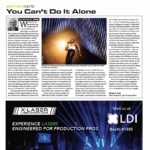PLSN Co-Editors Michael S. Eddy and Debi Moen each penned an Editor’s Note for the July issue. They appear below:
Technology that Moves Us
After moderating the Pro Production panels at NAMM, where we discussed audience engagement using entertainment technology in the metaverse, as well as how production elements onstage brand a band for an audience, I have found myself thinking about the intersection between entertainment technology and connecting emotionally with an audience, but in new, unexpected venues. This month I cover two non-music projects that both used live entertainment technology to create strong emotional engagements.
The first was the NETFLIX Stranger Things activation that appeared to ‘open rifts’ on 15 global landmarks into the show’s Upside Down realm. NYC’s Empire State Building’s lighting and projection mapped 15-minute looping show kept the streets jammed with crowds applauding and questioning ‘How did they do that?’. The same crowd engagement happened globally, with social media lighting up, as people encouraged friends and family to ‘get down here and see this!’. The excitement, the applause caused not by a band on a rooftop, only projectors and lights. Entertainment technology that stopped NYC traffic.
Then there was the Queen’s Platinum Jubilee Pageant with a video avatar of a 27-year-old Queen Elizabeth II on her Coronation Day returning to the Palace in the Gold State Coach. Seventy years later, thanks to live entertainment technology, the young Queen was seen once more sitting in the historic 260-year-old coach waving as she passed by the modern crowd celebrating her reign. Using LED panels inside the moving coach and a painstakingly created 20-second clip loop, her Majesty smiled, waved, and even turned to look around in her seat along the route. It so viscerally connected with many in the crowd that they even waved back. An immersive moment that transported today’s spectators to the same experience as the crowds standing in the same spot 70 years early.
It’s easy for us to be jaded in this industry; we know how the ‘magic tricks’ work. But isn’t there still something magic to being part of creating moments that emotionally move whole crowds?
Michael S. Eddy, Co-Editor of PLSN
Fanciful Escapes
Approaching my gate at the airport, I was taken aback. A row of seats seemingly melted into the wall until they disappeared. A digital display listed destinations of Atlantis, Brigadoon, Camelot, Fraggle Rock, Valhalla and more mythical places, and on airlines named UTOPIAir, ODDyssey and Spellbound. A whimsical PA announcement further confused me: “Wistful Airlines is boarding for The Night Kitchen, through the dark and over the top of the Milky Way, whose weather at this time is dream-like.” And then I spied an ornate ticket kiosk built into the wall, which asked endless loops of questions through its touchscreen, like “How much is enough?” No matter the answer, tickets did not emerge. Two doors cracked open with bright heavenly light (I’m guessing LED) streaming through were marked as the “Portal to Interimaginary Destinations.” It beckoned me to tug on it. Of course it didn’t budge.
And then all was revealed. A sign declared it a temporary art installation—Interimaginary Departures, by Brooklyn, NY-based artist Janet Zweig. Ah. I loved that it swept me out of the stress of my upcoming flight; it freed my mind from the fret of travelers in the “real” section of the gate, furious about flight delays. I sat in part of the chair that was “melting” into the wall and thought about how art allows us to escape to places unreachable by physical transport. I was on my way to L.A. from Austin, TX, but my thoughts were taking off to Utopia.
Festivals, a focus in this issue (see page 22), are also designed for fanciful flights of the soul. There’s a road map for making the productions run smoothly, but the landscape has been altered. We look at the template of the production designer’s interimaginary destinations, and the companies which, in turn, help make these live events—which one could call temporary art installations—a reality.
Debi Moen, Co-Editor of PLSN


